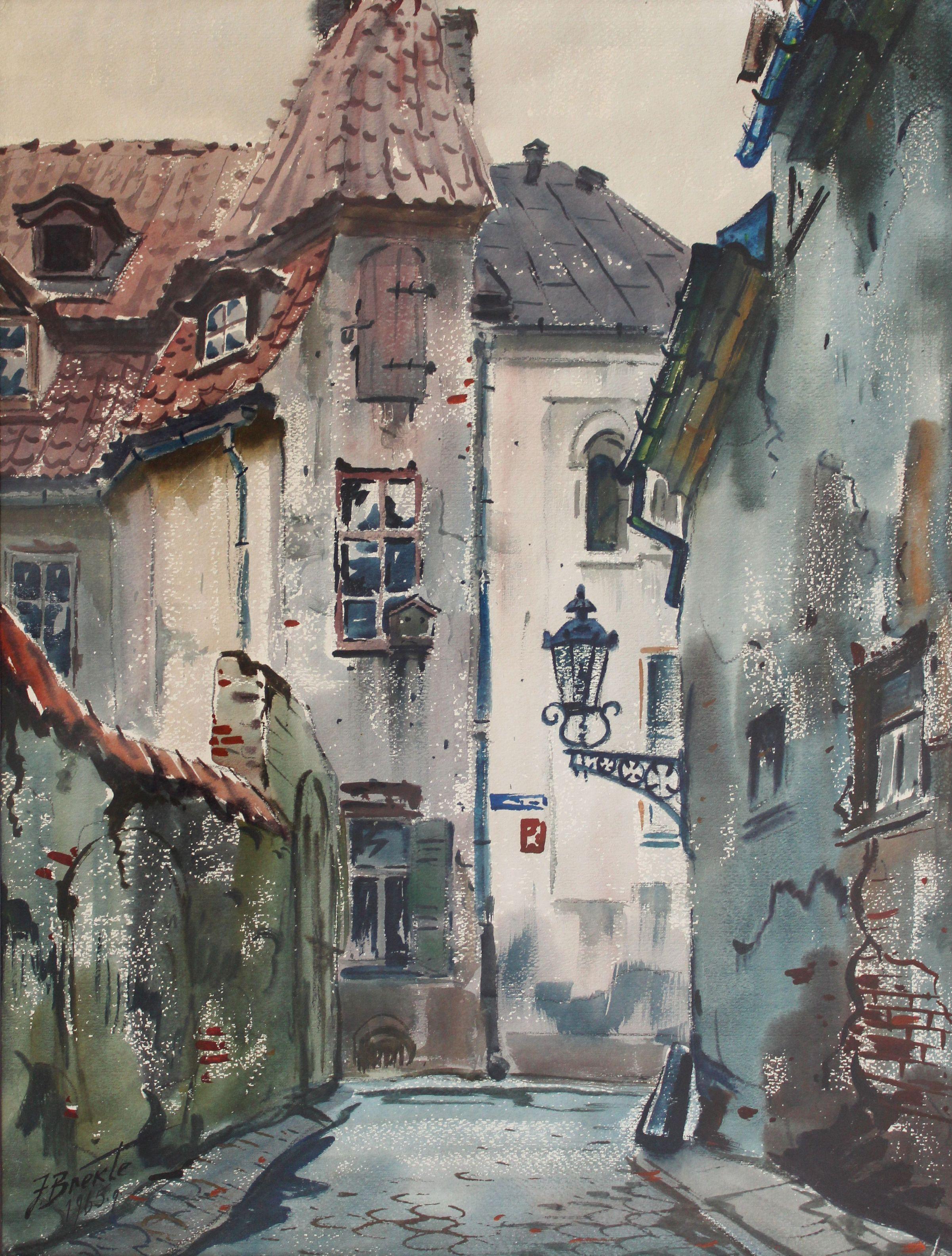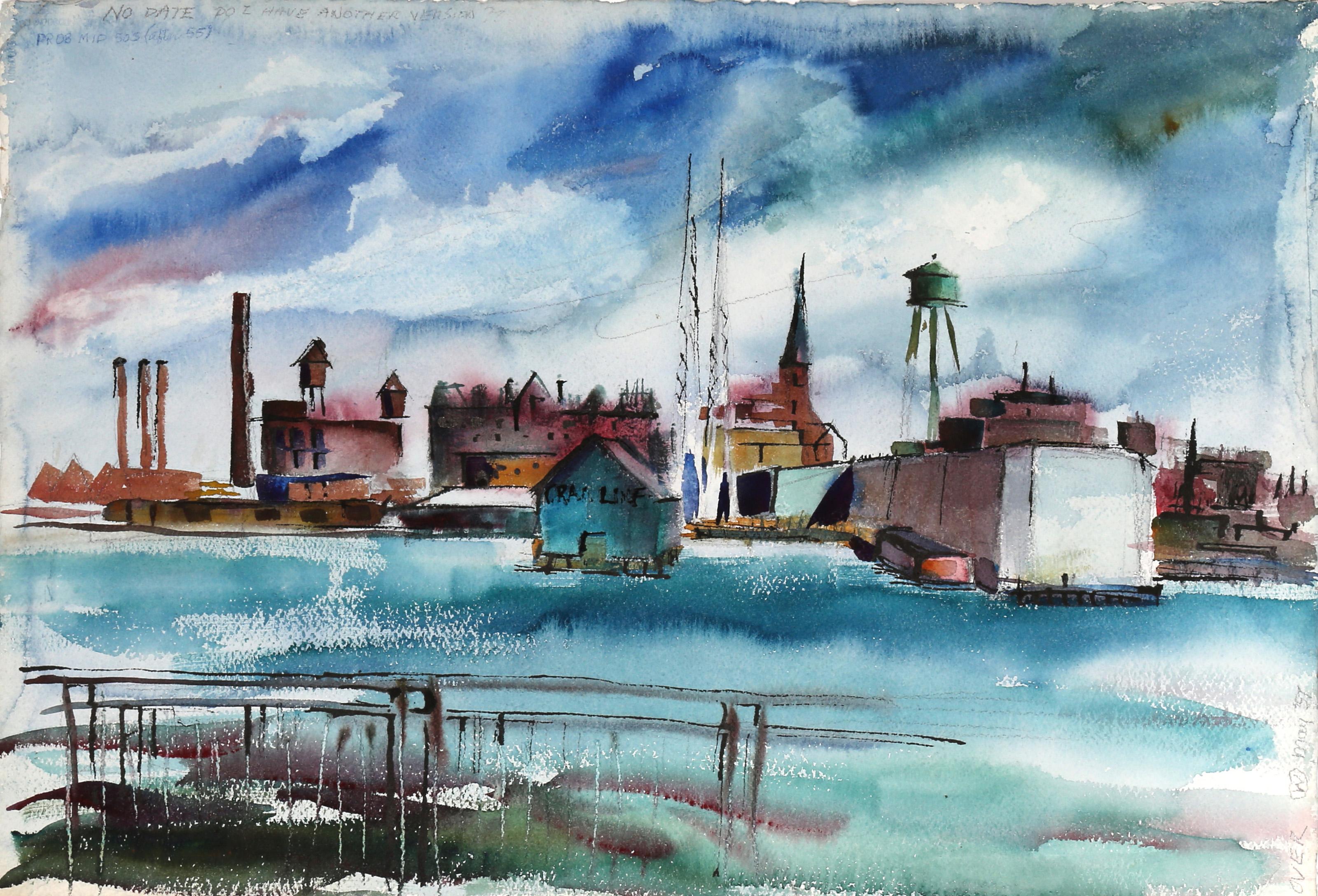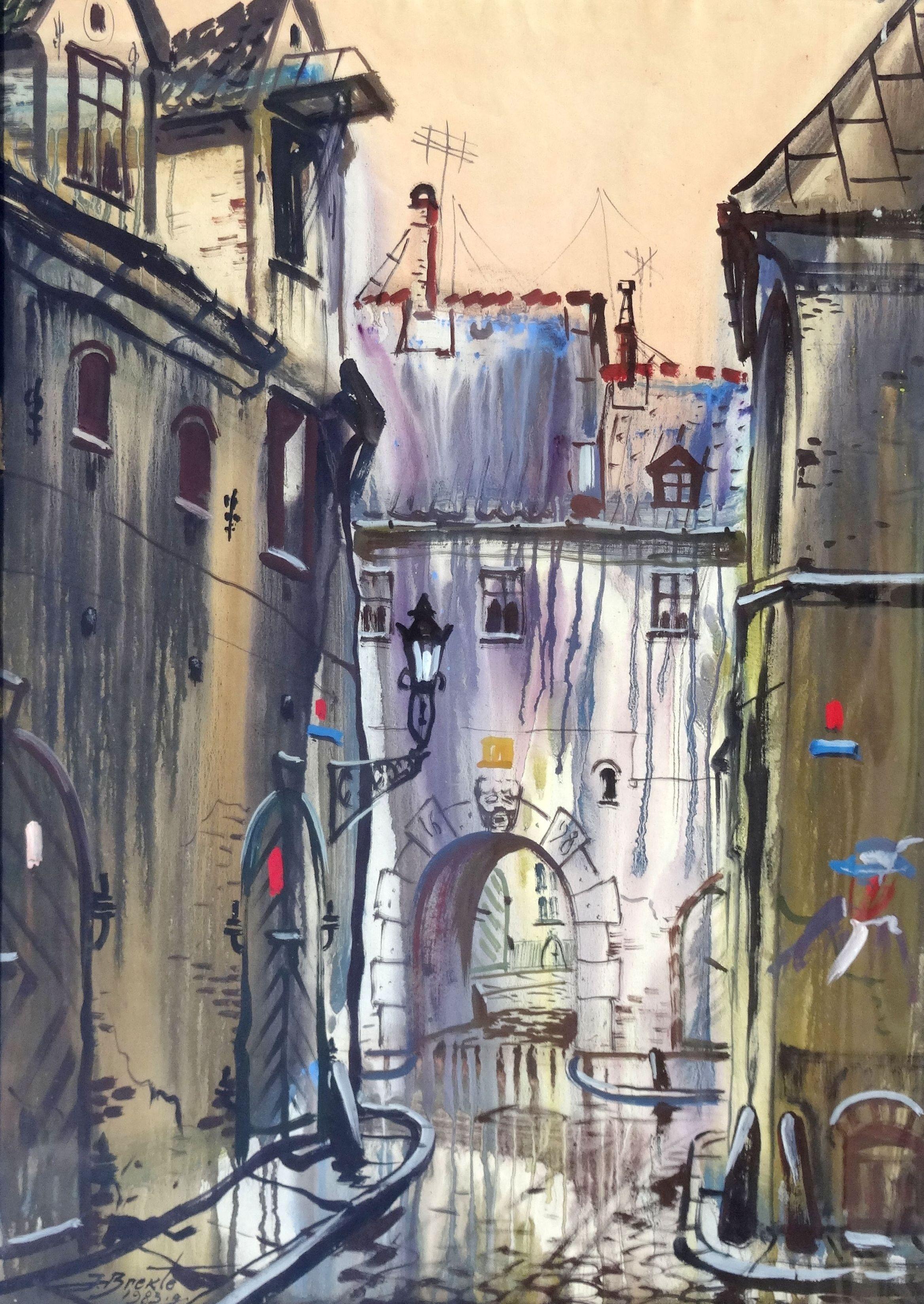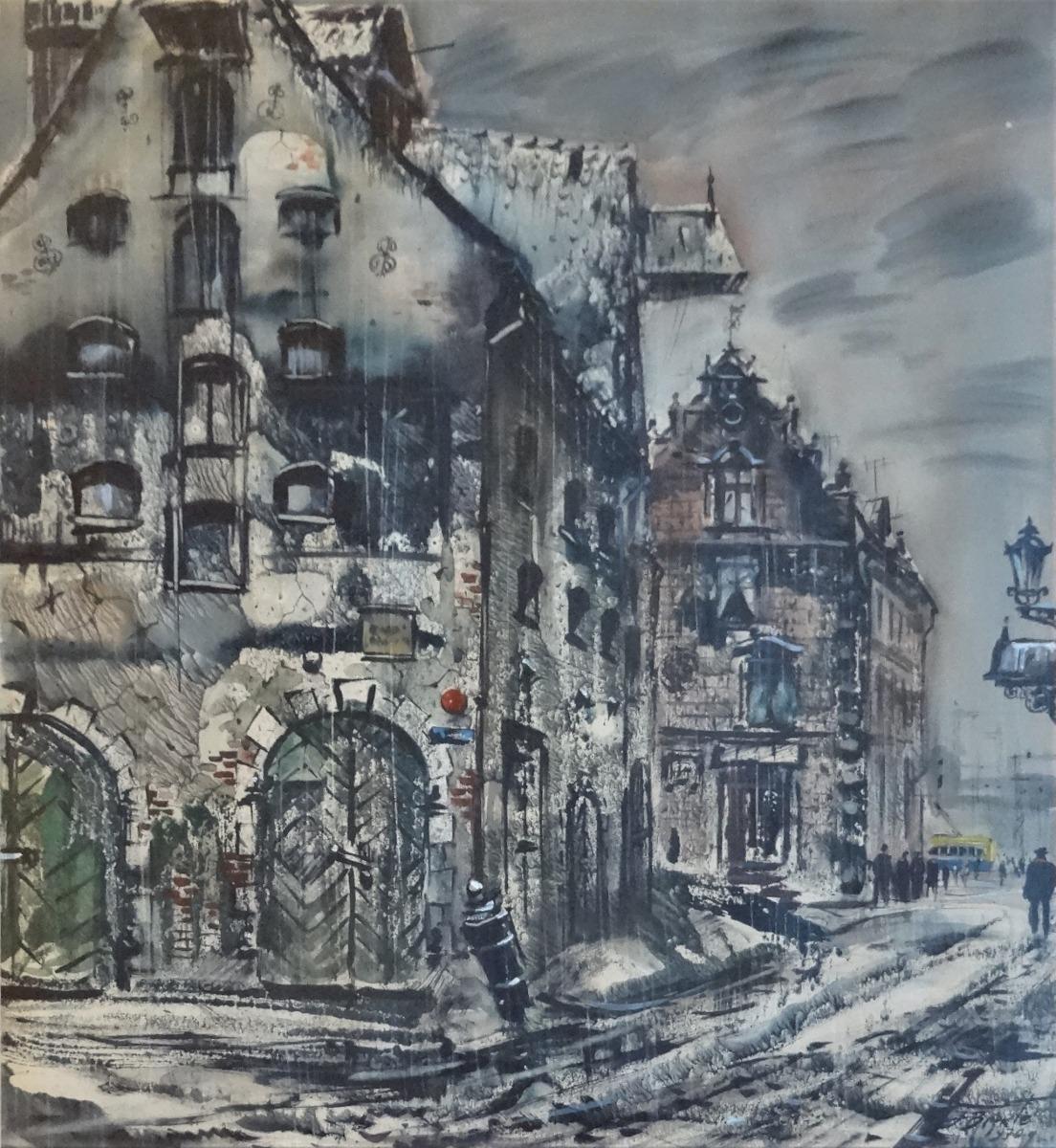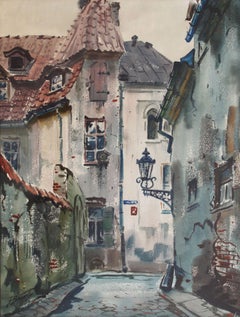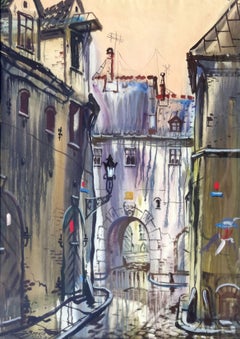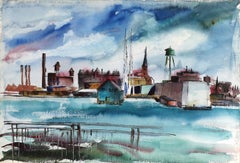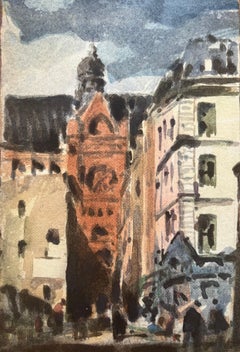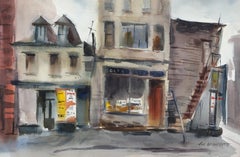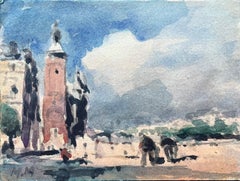Items Similar to View of the old town, paper/watercolor, 83x59.5 cm
Want more images or videos?
Request additional images or videos from the seller
1 of 8
Edwin AndersonsView of the old town, paper/watercolor, 83x59.5 cm1986
1986
$1,067.21
£793.40
€900
CA$1,478.97
A$1,648.76
CHF 859.90
MX$19,937.39
NOK 10,809.35
SEK 10,227.80
DKK 6,851.93
About the Item
Old Riga. 1986. Paper, watercolor, 47x34 cm
Street view in old city at winter
Edwin Andersons (1929-1996)
1956 – graduating Art Academy of Latvia, department of graphic art (diploma work – „The building of State Farmers' house under the direction of G.Vasco.
Since 1955 he has participated in exhibitions.
Since 1958, a member of the Union of Artists.
He worked in the graphic direction, book design, in watercolor and also in journalism. His work are characterized by contrast, contrast opposites, monometallism and decorative. One of the most active graphic artist of 50-ties, “which his journalistic aspirations tried to correlate with officially registered requirement of those times, was often in conflict with reality ”(L. Reihmane)
Basically he worked in lithographs technique (the cycle "New Riga", "HPP in .Plavina", "BAM", "Riga").
The artist was a perfect lithography master, although at those times there was a tradition to make copies by master, but E. Anderson made them by himself. In 50-60-ies artist made large figurative compositions, which are printed in in exemplary typography.
The cultural heritage of the artist - recognizable side streets of Old Town of Riga in technique of engraving.
- Creator:
- Creation Year:1986
- Dimensions:Height: 32.68 in (83 cm)Width: 23.23 in (59 cm)Depth: 0.04 in (1 mm)
- Medium:
- Movement & Style:
- Period:
- Framing:Framing Options Available
- Condition:
- Gallery Location:Riga, LV
- Reference Number:1stDibs: LU1437216152262
About the Seller
5.0
Gold Seller
Premium sellers maintaining a 4.3+ rating and 24-hour response times
Established in 2002
1stDibs seller since 2020
196 sales on 1stDibs
Typical response time: 12 hours
- ShippingRetrieving quote...Shipping from: Riga, Latvia
- Return Policy
Authenticity Guarantee
In the unlikely event there’s an issue with an item’s authenticity, contact us within 1 year for a full refund. DetailsMoney-Back Guarantee
If your item is not as described, is damaged in transit, or does not arrive, contact us within 7 days for a full refund. Details24-Hour Cancellation
You have a 24-hour grace period in which to reconsider your purchase, with no questions asked.Vetted Professional Sellers
Our world-class sellers must adhere to strict standards for service and quality, maintaining the integrity of our listings.Price-Match Guarantee
If you find that a seller listed the same item for a lower price elsewhere, we’ll match it.Trusted Global Delivery
Our best-in-class carrier network provides specialized shipping options worldwide, including custom delivery.More From This Seller
View AllOld City. 1986. Paper, watercolor, 47x34 cm
By Edwin Andersons
Located in Riga, LV
Old Riga. 1986. Paper, watercolor, 47x34 cm
Street view in old city at winter
Edwin Andersons (1929-1996)
1956 – graduating Art Academy of Latvia, de...
Category
1980s Impressionist Landscape Paintings
Materials
Paper, Watercolor
$758 Sale Price
20% Off
Old City. 1970. Paper, watercolor, 46x37 cm
By Edwin Andersons
Located in Riga, LV
Old city. 1970. Paper, watercolor, 46x37 cm
Street view in old city
Edwin Andersons (1929-1996)
1956 – graduating Art Academy of Latvia, department o...
Category
1970s Impressionist Landscape Paintings
Materials
Paper, Watercolor
$469 Sale Price
20% Off
Old Town. 1965, watercolor on paper, 70 x 54 cm
Located in Riga, LV
Old Town. 1965, watercolor on paper, 70 x 54 cm
Through the use of watercolors on paper, the artist has created a nostalgic and picturesque portrayal of the landscape, inviting view...
Category
1960s Realist Landscape Paintings
Materials
Paper, Watercolor
Old Town 1983, paper, watercolor, 85x60 cm
Located in Riga, LV
Old Town 1983, paper, watercolor, 85x60 cm
The central focus of the painting is an old town, a historic district known for its antiquated architecture, cobbled streets, and a sense of bygone eras. Watercolor technique allows for the depiction of the old town's buildings, streets, and landmarks with a loose and expressive style. The fluidity of watercolors can evoke a sense of movement and spontaneity, giving the cityscape a lively and vibrant feel.
Janis Brekte...
Category
1980s Realist Landscape Paintings
Materials
Paper, Watercolor
$1,707 Sale Price
20% Off
Old City 1970. Paper, watercolor, 71x64 cm
Located in Riga, LV
Old City 1970. Paper, watercolor, 71x64 cm
"Old Town" is a visually captivating and evocative watercolor painting, celebrating the timeless allure of an old cityscape. Through the use of watercolors on paper, the artist has created a nostalgic and picturesque portrayal of the old town's unique character and historical charm, inviting viewers to appreciate the beauty of the urban past.
Janis Brekte...
Category
1970s Realist Landscape Paintings
Materials
Paper, Watercolor
$1,707 Sale Price
20% Off
Old Town. 1971. Watercolor on paper, 56x41 cm
Located in Riga, LV
Old Town Riga
1971. Watercolor on paper, 56x41 cm
The central focus of the artwork is on an old town, a historic district known for its antiquated architecture, cobbled streets, an...
Category
1970s Realist Landscape Paintings
Materials
Paper, Watercolor
You May Also Like
City View, Impressionist Watercolor by Eve Nethercott
By Eve Nethercott
Located in Long Island City, NY
Eve Nethercott, American (1925 - 2015) - City View (P5.71), Year: 1957, Medium: Watercolor on Paper, Size: 15 x 22 in. (38.1 x 55.88 cm), Description: A unique watercolor on ...
Category
1950s Impressionist Landscape Drawings and Watercolors
Materials
Watercolor
French Impressionist Watercolor Street Scene with Prominent Red Brick Building
Located in Cirencester, Gloucestershire
Title: French Impressionist Watercolor Street Scene with Prominent Red Brick Building
By Maurice Mazeilie (French 1924-2021)
Medium: Watercolor on paper, unframed
Size: 6.75 x 4.75 i...
Category
20th Century Impressionist Drawings and Watercolor Paintings
Materials
Watercolor
Chinatown, Impressionist Watercolor by Eve Nethercott
By Eve Nethercott
Located in Long Island City, NY
Eve Nethercott, American (1925 - 2015) - Chinatown (P4.22), Year: 1961, Medium: Watercolor on Paper, Size: 13.5 x 20.5 in. (34.29 x 52.07 cm), Description: Eve Nethercott's s...
Category
1960s Impressionist Landscape Drawings and Watercolors
Materials
Watercolor
French Impressionist Watercolor of Cityscape with Tower and Figures
Located in Cirencester, Gloucestershire
Title: French Impressionist Watercolor of Cityscape with Tower and Figures
By Maurice Mazeilie (French 1924-2021)
Medium: Watercolor on paper, unframed
Size: 4.75 x 6.25 inches (Heig...
Category
20th Century Impressionist Drawings and Watercolor Paintings
Materials
Watercolor
City Street, Impressionist Watercolor by Eve Nethercott
By Eve Nethercott
Located in Long Island City, NY
Eve Nethercott, American (1925 - 2015) - City Street (49), Year: circa 1959, Medium: Watercolor, Size: 15 in. x 11 in. (38.1 cm x 27.94 cm), Description: A unique watercolor on...
Category
1950s Impressionist Landscape Drawings and Watercolors
Materials
Watercolor
French Impressionist Watercolor Parisian Street Scene with Cathedral and Bridge
Located in Cirencester, Gloucestershire
Title: French Impressionist Watercolor Parisian Street Scene with Cathedral and Bridge
By Maurice Mazeilie (French 1924-2021)
Medium: Watercolor on paper, unframed
Size: 9.5 x 12.5 i...
Category
20th Century Impressionist Drawings and Watercolor Paintings
Materials
Watercolor
More Ways To Browse
Anderson Lithograph
L Anderson
Bam Bam Vintage
New England Barn
Place De La Concorde
Plein Aire Art
Rocky Poster
Salt Marsh Painting
Seascape Maine
Antique Original Paintings Boston
Apple Blossom
Florida Seascape Painting
Heavy Horses Paintings
Lancaster Oil Painting
Laundry Painting
Misty Morning Painting
The Furies
Tudor Painting
